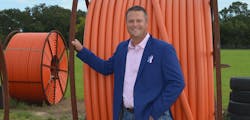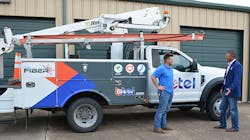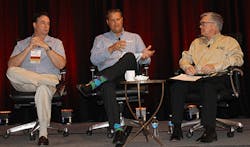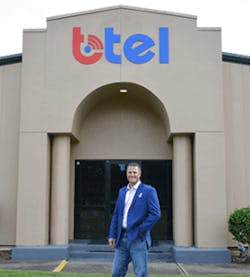Executive Insights With Charlie Greenberg, CEO/President, Btel (Brazoria Telephone Company)
Topic: COVID-19 Impact
ISE magazine: How is Btel impacted by the COVID-19 pandemic?
Greenberg: COVID–19 became a reality for us at Btel at the beginning of March 2020. I remember processing the news and thinking Is this really happening? We started our process by blowing the dust off our pandemic plan and thinking we are covered. Wow, did things escalate quickly! Infections started spiking on the east and west coast, and then spread into Houston, our closest major metropolitan area (Btel is about 50 miles south). We knew that it was only a matter of time before we started seeing positive cases in and around Brazoria, so we started implementing precautions to help protect both our employees and customers.
Initially we closed the front office to walk-in traffic, started dispatching our outside plant technicians from home, and allowed employees who could work from home to do so. Additionally, the departments that were required to work from the office were divided in half and worked in separate buildings without physical interaction. As our employees were adjusting to their new work environments, businesses everywhere were sending their staff home to work, and schools were closing their doors with the expectation that students would learn from home.
This created an enormous demand for Broadband usage which increased 60% across our network. The significant increase in usage and the critical need for high-speed Internet quickly became apparent to many of our customers who had not subscribed to sufficient Broadband speeds to accommodate their needs. With all the economic uncertainty, we felt like our customers could use a break, so Btel began offering free upgrades to our customers across our network, and also waived all installation fees for new service.
InvisiLight® Solution for Deploying Fiber
April 2, 2022Go to Market Faster. Speed up Network Deployment
April 2, 2022Episode 10: Fiber Optic Closure Specs Explained…
April 1, 2022Food for Thought from Our 2022 ICT Visionaries
April 1, 2022As the orders came rushing in to Btel, our employees went to work doing whatever was required to provide the highest quality of bandwidth available. Whether it was bonding pairs for DSL, grooming the network to allow for more bandwidth, or assisting customers with issues within the home, the employees at Btel stepped up to the challenge in every way. I am very proud of the performance of our Btel employees in these difficult circumstances, and the tremendous effort put forth in serving our community.
Topic: In-Home Connection Speeds and QoS
Today, only 7% of civilian workers in the US, or roughly 9.8 million of the nation’s approximately 140 million civilian workers, have access to a "flexible workplace" benefit, or telework, according to the 2019 National Compensation Survey (NCS) (https://www.bls.gov/ncs/ebs/) from the federal Bureau of Labor Statistics. And those workers who have access to it are largely managers, other white-collar professionals, and the highly paid. ("Civilian workers" refers to private industry workers and state and local government workers combined.)
The ongoing shift to remote work will continue to drive demand for network infrastructure and connectivity. However, the demand could also strain the system and lead to public perception issues if reality doesn’t meet expectations.
ISE magazine: How is Btel increasing home network speeds, and reducing latency and packet drops as workers rely more and more on video collaboration tools such as Zoom, WebEx, GoToMeeting, etc?
Greenberg: Btel delivers services over 3 different networks:
1. Fiber-to-the-Home is a superior product for delivering Broadband services of any type. Once in place, customers report very little trouble with service quality and we can provide the customer with any speed they require.
2. Hybrid Fiber Coax (cable modem) provides a high-quality Broadband service with the ability to provide high speeds, but the fiber nodes must be managed to share bandwidth across the customers connected to each node. If the nodes are improperly managed, then there can be a higher demand than the node can handle, creating slow speeds and increased latency on the network.
3. Twisted pair (DSL) supports our DSL customers, and while the service quality is good and the latency is not typically a problem, DSL cannot support higher speeds. Our challenge is that many of our DSL customers exist in very rural sections of our exchange where there are long loop lengths. We use pair bonding to provide customers in these areas with the maximum bandwidth available, but there are limitations with DSL capability.
Each network platform provides different levels of service quality, but it is always our goal to operate a highly dependable network providing the highest speeds possible for our customers.
Topic: Priorities
ISE magazine: What are Btel’s 2020-2021 priorities?
Greenberg: The COVID-19 pandemic is having a profound impact on our society, and it does not seem to be going away anytime soon. This presents a challenging landscape for planning and forecasting. But we will continue to improve our business operations and focus on positive changes and opportunities. Internal to Btel, we are continuing to drive data analytics, and complement it with auto provisioning to help streamline our processes and procedures, deliver managed services to an expanded customer base, and continuing to build fiber plant.
Topic: Network Transformation
ISE magazine: What is the most challenging thing about working to transform Btel to meet the realities
of your customers in the new normal of our hyper-connected society? What is the great joy of watching
the transformation of Btel?
Greenberg: I’ve always said, "Years ago, as a regulated Monopoly, we provided our customers with the products and services we thought they needed. But in today’s communications landscape, we must provide our customers with the products and services that they want." This is a very different way of doing business, but our team here at Btel is up for the challenge.
We live in a data-driven world, and as a result we have installed some of the best data analytics platforms to help us better understand our customers, their trends, their habits, and any issues that they might be having. We do all of this to better serve our customers.
If we can solve problems before a trouble ticket is issued, offer solutions that make sense, and or initiate a dialog that helps a customer understand and educate themselves, we are empowering our customers to maximize our network, which is the best customer service that we can offer.
The transformation from our old way of doing business to the innovative way the Btel team operates today has truly been awe-inspiring. Letting go of old procedures and the paper trail that follows can be tough, but seeing our team maximize our systems to better serve our customers is an awesome feeling.
Topic: Rural Realities
ISE magazine: What are your biggest challenges or obstacles to deliver higher speeds to your customers?
Greenberg: The wide-open spaces in rural Texas! Btel has the technology, and we do a great job of deploying it, but distance verses CapEx is our biggest issue. We are making good progress building fiber, and plan to continue construction. Our legacy plant still provides good service, but as bandwidth requirements continue to grow, it will become more and more difficult to deliver quality service over those facilities.
We have not gotten into the wireless business as of today, but recognize it is an option that may be required going forward. Like I said before, providing our customers with the products and services that they want is our goal, and we intend to deliver it.
Topic: Cultural Transformation
ISE magazine: Explain why cultural transformation is as important as technical transformation to ensure that communications service providers (CSPs) like Btel succeed in the new normal.
Greenberg: Technology is only as good as a company’s willingness to embrace it, and that is where culture sinks or swims. We have a strong culture here at Btel of embracing and evolving with technology. Are we perfect? No, but culture is something we talk about a lot as a management team. We believe it is critical to be mindful of the culture that exists in the company, and to be willing to cultivate the positive and address the negative.
For Btel to succeed, each employee must embrace change when technological innovation requires it, but
also when processes and customer interaction has changed. Onboarding new employees can be very disruptive to a company’s culture, and regardless of a person’s technical skills, if they do not work well with the team, everyone suffers, and petty distractions rule the day.
Topic: Field Techs’ Evolution
ISE magazine: Share how your field techs’ methods and procedures have changed given the COVID-19 environment. How do you train your techs in both hard skills and soft skills so that they can remain safe while being the face of your company to your customers?
Greenberg: Btel is not a large company, and therefore I have the luxury of knowing all our field techs on a first-name basis. This group of employees have a culture (or soft skills) that drive them to help and support our customers. Naturally, they adjust techniques to compensate for challenges.
Through the COVID-19 pandemic, techs have been asked to step up in a time of need, strap on their Personal Protective Equipment (PPE), and continue delivering communication services. (Even when their goofy CEO thinks it is a good idea to offer free installs and free bandwidth upgrades to all customers.)
Like many people in the industry we have experienced growth through the COVID-19 experience as a result of customers working from home and our students learning from home. This growth lands squarely on the shoulders of these techs and the employees that support them.
We have experienced periods when we did not allow our techs to enter homes, yet still allow them to assist with customer installs. This is when you can really see our techs’ training shine (Hard Skills). It’s powerful to have them sitting in their company truck in a customer’s driveway, directing the customer’s hands through an install so our customer can get the bandwidth needed to work and learn from home.
Again, I cannot say enough about how proud I am of our team for how they have carried Btel during the pandemic.
Topic: Guidance
ISE magazine: What professional and leadership guidance would you offer a younger Charlie Greenberg as he was forging his career path?
Greenberg: In order to achieve great things, you must have vision, drive, focus, and a positive attitude. Surround yourself with people who care about our services, customers, and fellow employees. Share your ideas and vision with the team, and empower them to help you accomplish your goals. I believe in the power of a team, and to have a great team everyone needs to know their role and contribute to the best of their ability. I also believe that there must be a leader of the team that is willing to listen and coach, absorb the feedback from the team, and set the best direction to pursue. I know it sounds simple, but most principles are basic, and tend to fail when they get complicated.
Topic: Failure
ISE magazine: How do you embrace failure and encourage risk-taking across your organization?
Greenberg: This one can be tricky, because there is a fine line between failure and accountability. Good business starts with defining the direction you want to go and the goals you wish to achieve.
I see failure as a recognition that things are not going as planned, but not taking action to fix the problem. The trick is to recognize when something is failing, understand the environment that it is failing in, and implement a solution to redirect the course and refocus on the goal. In this environment, responsible risk-taking can be encouraged and best practices are identified.
In today’s world of data analytics there are a multitude of platforms that assist with project management. Using these tools and maximizing data points is critical.
Topic: YOU!
ISE magazine: Tell us the story of how and why you came to lead Btel. Share the advantages and disadvantages to leading your team in this environment.
Greenberg: Btel is a family owned and operated company, and I represent the fourth generation of leadership. I can remember the day that I scotch-locked my first cable pair, configured my first router, and led my first management meeting.
My father always believed the best way to understand the business was to work from the bottom up, so I started on the maintenance crew, clearing brush and poison ivy away from pedestals. Fast forward 25-30 years, and here I am today. Many of our employees that I worked with over the years are still here, and we hold a high level of respect for each other. Our roles may be different today, but as we are leading Btel through uncertain times, the trust and respect that we have for one another is a huge advantage.
When I think about the disadvantages to the path that got me to where I am today, I will pass on answering that. There are way too many people that work for Btel that have dirt on me!
Topic: Myth
ISE magazine: What is the greatest myth about being a CEO/President?
Greenberg: "It’s lonely at the top." I just don’t buy it. We have a great team at Btel, and we do a good job of supporting each other. Just because there might be tough decisions from time to time, this does not make it lonely; maybe unpopular, but not lonely.
Btel is one of Texas’ oldest telephone companies with roots going back to 1907. It was purchased by Charles and Beulah Hendrix in 1946, and remains an independent, family-owned company with current President and CEO Charlie Greenberg being the 4th generation of family leading the organization. Many of our employees have been with Btel their entire career, and are key contributors to the massive transition from a traditional rural telephone company providing POTS to a modern communications company focused on providing the technology and critical services our customers need.
Most Btel customers live in unincorporated areas; with a population of 3,200 people, the City of Brazoria is the largest population center in the service territory. The area has 2 rivers flowing through Brazoria which are prone to flooding, and with the risk of high winds and hurricanes on the coast, building and maintaining a network in this territory can be challenging.
Like this Article?
Subscribe to ISE magazine and start receiving your FREE monthly copy today!
Btel was significantly impacted by the unprecedented flooding of Hurricane Harvey in 2017, with a third of the network under water for over a week. The resulting damage required an unprecedented effort from Btel to expedite repairs. The impact of the extensive flooding on our facilities also clarified our vision to significantly expand our fiber-to-the-home construction efforts. Substantial investments in fiber technology over the last few years have provided the vast majority of our customers with high-speed connections.
About the Author
Sharon Vollman
Content Ambassador for ISE EXPO
Sharon Vollman is the Content Ambassador for ISE EXPO. She is passionate about collaborating with thought leaders, SMEs and hard-working doers who design, plan and deploy ultra-reliable broadband networks. Vollman is committed to creating a variety of educational offerings for ISE EXPO attendees that inspire them to connect every U.S. citizen with the broadband networks we all want for our children and grandchildren.
Vollman has created educational partnerships with Broadband Service Providers including AT&T, Verizon, Lumen, Frontier Communications and others. She has covered the telecom industry since 1996.








